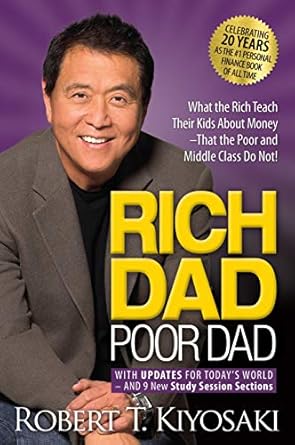“Rich Dad Poor Dad” by Robert Kiyosaki
Who is it for? for those thinking about money, investing, and wealth building
“Rich Dad Poor Dad” by Robert Kiyosaki is a groundbreaking personal finance book that has significantly influenced the way people think about money, investing, and wealth building. The book contrasts the financial philosophies of two influential figures in Kiyosaki’s life: his own father, the ‘poor dad,’ an educated and hardworking man who struggled financially, and his friend’s father, the ‘rich dad,’ who, despite a lack of formal education, achieved significant financial success.
Kiyosaki uses the stories and lessons from these two paternal figures to challenge conventional wisdom about money, such as the importance of earning a high salary and the traditional path of higher education leading to financial security. He advocates for financial literacy, investment in assets over liabilities, and the development of entrepreneurial skills as pathways to wealth.
One of the main challenges readers may face is applying Kiyosaki’s principles to their personal financial situations. While the book offers valuable insights into wealth building and financial independence, translating these ideas into actionable steps can be complex, particularly for those with limited financial education or resources.
Another challenge is the potential risk involved in Kiyosaki’s recommended strategies, such as real estate investing and starting a business. These ventures require capital, risk tolerance, and a level of expertise that not all readers may possess. Balancing Kiyosaki’s advice with one’s risk profile and financial situation is crucial.
Additionally, some critics argue that the book oversimplifies complex financial concepts and does not adequately address the importance of diversification and the potential downsides of leveraged investing. Readers must critically assess these strategies and consider seeking additional financial advice.
In summary, “Rich Dad Poor Dad” is a thought-provoking and potentially life-changing book for those looking to rethink their approach to personal finance and wealth. The challenge lies in critically assessing, adapting, and safely applying Kiyosaki’s principles to one’s own financial journey. For readers open to challenging traditional financial beliefs and exploring entrepreneurial and investment opportunities, this book can offer valuable guidance and inspiration.

